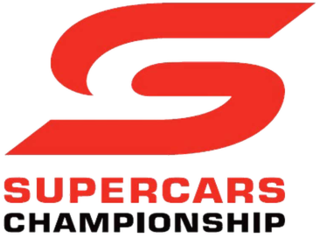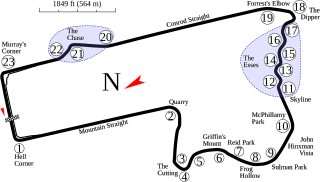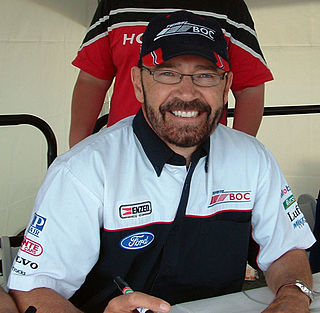
Touring car racing is a motorsport road racing competition that uses race prepared touring cars. It has both similarities to and significant differences from stock car racing, which is popular in the United States.

The Supercars Championship currently known as the Repco Supercars Championship under sponsorship, is a touring car racing category in Australia and New Zealand, running as an International Series under Fédération Internationale de l'Automobile (FIA) regulations, governing the sport.

Group A is a set of motorsport regulations administered by the FIA covering production derived touring cars for competition, usually in touring car racing and rallying. In contrast to the short-lived Group B and Group C, Group A vehicles were limited in terms of power, weight, allowed technology and overall cost. Group A was aimed at ensuring numerous entries in races of privately owned vehicles.

The Bathurst 1000 is a 1,000-kilometre (621.4 mi) touring car race held annually on the Mount Panorama Circuit in Bathurst, New South Wales, Australia. It is currently run as part of the Supercars Championship, the most recent incarnation of the Australian Touring Car Championship. In 1987 it was a round of the World Touring Car Championship. The Bathurst 1000 is colloquially known as The Great Race among motorsport fans and media. The race originated with the 1960 Armstrong 500 with a 500 mile race distance at the Phillip Island Grand Prix Circuit; it was relocated to Bathurst in 1963 also with the 500 mile distance and has continued there every year since extending to a 1,000 kilometer race in 1973. The race was traditionally run on the New South Wales Labour-Day long weekend in early October. Since 2001, the race has been run on the weekend following the long weekend, generally the second weekend of October.

Super Touring, Class 2 or Class II was a motor racing Touring Cars category defined by the Fédération Internationale de l'Automobile (FIA) for national touring car racing in 1993. It was based on the "2 litre Touring Car Formula" created for the British Touring Car Championship (BTCC) in 1990. The FIA organised a World Cup for the category each year from 1993 to 1995, and adopted the term "Super Tourer" from 1995.
The Australian Touring Car Championship (ATCC) is a touring car racing award held in Australia since 1960. The series itself is no longer contested, but the title lives on, with the winner of the Repco Supercars Championship awarded the trophy and title of Australian Touring Car Champion.

Aussie Racing Cars (ARC) is an Australian motor racing category. ARC is a motorcycle powered silhouette racing car class created by former touring car racing driver Phil Ward and influenced by the American Legends category. Aussie Racing Cars was developed as a Major National Category supporting the V8 Supercars under an exclusive Category Management Agreement (CMA) with the Confederation of Australian Motorsport (CAMS).

John Philip Bowe is an Australian racing driver, presently racing a Holden Torana in the Touring Car Masters series.

The Australian Nations Cup Championship was a motor racing title sanctioned by the Confederation of Australian Motor Sport (CAMS) from 2000 to 2004.

The 1998 AMP Bathurst 1000 was the 40th running of the Bathurst 1000 touring car race. It was held on 4 October 1998 at the Mount Panorama Circuit just outside Bathurst. It was the second year of the controversial split between race organisers, the Australian Racing Drivers Club, and V8 Supercar, which had led to Australia's leading touring car series leaving the Bathurst 1000. The V8 Supercar teams raced the 1998 FAI 1000 race, held six weeks later. The race distance was 161 laps, approximately 1000 km.
The 1987 Australian Touring Car Championship was a motor racing competition which was open to Touring Cars complying with regulations as defined by the Confederation of Australian Motor Sport and based on FIA Group A rules. The championship, which was the 28th Australian Touring Car Championship, began on 1 March 1987 at Calder Park Raceway and ended on 5 July at Oran Park Raceway after nine rounds. The Calder round saw the world debut of the racing versions of the BMW M3, the Ford Sierra RS Cosworth and the Alfa Romeo 75 Turbo.

The 1993 Tooheys 1000 was the 34th running of the Bathurst 1000 touring car race. It was held on 3 October 1993 at the Mount Panorama Circuit just outside Bathurst, New South Wales, Australia. The race was held for cars eligible under CAMS Group 3A Touring Car regulations, which included 5.0 litre V8 engined cars, International Class II 2.0 litre Touring Cars and naturally aspirated two wheel drive cars complying with 1992 CAMS Group 3A regulations.
The 1988 Australian Touring Car Championship was a CAMS sanctioned motor racing title for drivers of Group 3A Touring Cars. It was the 29th running of the Australian Touring Car Championship. The championship began on 6 March at Calder Park Raceway and ended on 17 July at Oran Park Raceway after nine rounds.
The 1986 Australian Touring Car Championship was an Australian motor racing competition for Touring Cars. It began on 2 March 1986 at Amaroo Park and ended on 13 July at Oran Park Raceway after ten rounds. The championship was authorised by the Confederation of Australian Motor Sport (CAMS) as an Australian National Title. It was the 27th Australian Touring Car Championship and the second to be contested by cars conforming with CAMS regulations based on the FIA's international Group A Touring Car regulations.
The 1985 Australian Touring Car Championship was a CAMS sanctioned motor racing title for drivers of Touring Cars. It was the 26th running of the Australian Touring Car Championship and the first to be contested using regulations based on the FIA's International Group A regulations after having been run under CAMS home grown Group C rules between 1973 and 1984. The championship began on 10 February 1985 at Winton Motor Raceway and ended on 14 July at Oran Park Raceway after ten rounds.
The 1986 Australian Touring Car season was the 27th season of touring car racing in Australia commencing from 1960 when the first Australian Touring Car Championship and the first Armstrong 500 were contested. It was the second season in which Australian Touring Car regulations were based on those for the FIA Group A Touring Car category.
Procar Australia was a motorsport category management company which operated in Australia from 1994 to 2004.
AMSCAR was a touring car series held in Australia between 1979 and 1997, based at Amaroo Park in Sydney.

The Winton SuperSprint was an annual motor racing event for Supercars, held at Winton Motor Raceway in Winton, Victoria. The event has been a regular part of the Supercars Championship—and its previous incarnations, the Australian Touring Car Championship, Shell Championship Series and V8 Supercars Championship—between 1985 and 2022.








